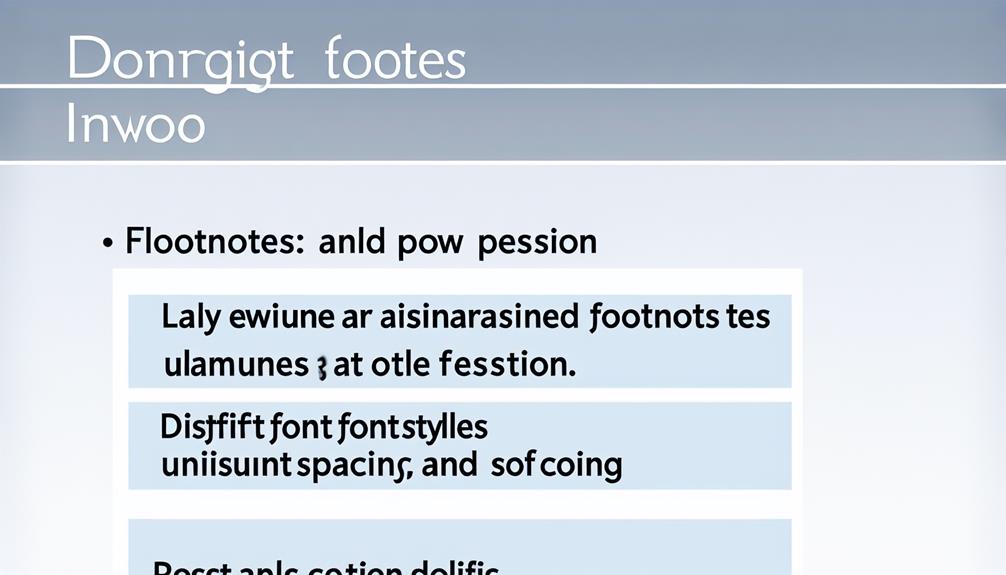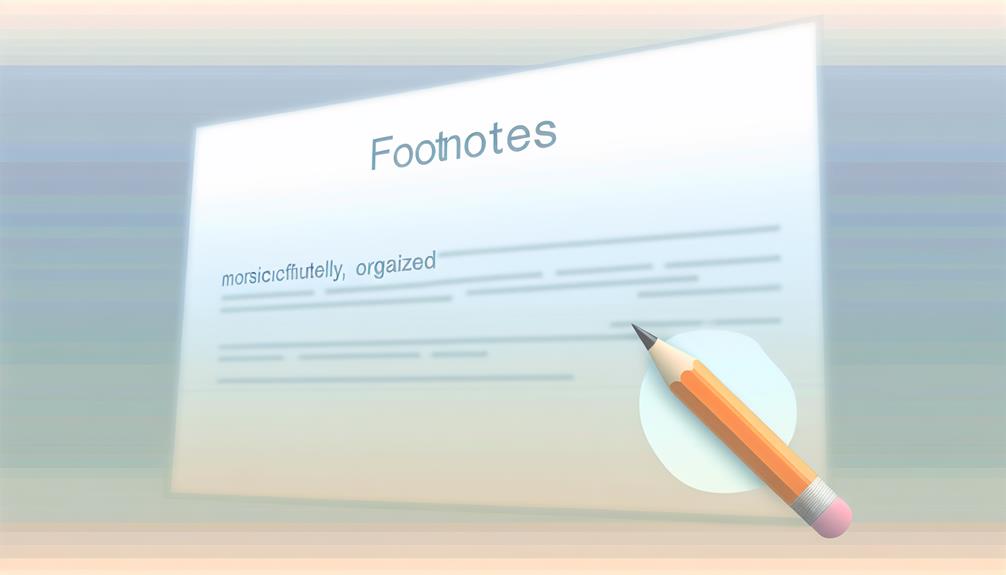Adding footnotes to PowerPoint slides is a simple yet effective way to provide additional context and citations without cluttering your main content. Start by aligning your footnotes with relevant content and using a consistent format throughout. Insert superscript numbers in your text to indicate footnotes, then place the corresponding information at the bottom of the slide. Verify the footnote font size is legible but unobtrusive, and maintain consistent margins for readability. By following these steps, you enhance the overall professionalism of your presentation while fostering greater audience engagement—discover more effective techniques for impactful presentations.
Key Takeaways
- Choose relevant content and reputable sources to enhance credibility and align with presentation objectives.
- Insert superscript numbers in the text for footnote placement, with a corresponding section at the bottom of the slide.
- Maintain consistent font size and placement for footnotes to ensure readability and a polished appearance.
- Keep footnotes concise, providing only essential information to avoid cluttering slides.
- Double-check citations for accuracy and adhere to proper documentation standards to maintain professionalism.
Understanding Footnotes

In the domain of academic and professional presentations, footnotes serve as essential tools for providing additional context and citations without cluttering the main content. Their role in enhancing the audience's understanding of complex topics is increasingly recognized as vital, especially when assessing trending products or services that may require justification. The footnote purpose is to offer readers supplementary information that enhances comprehension while maintaining the flow of the presentation. This practice is particularly valuable in establishing credibility, as it allows presenters to reference sources that underpin their arguments and assertions. Citation importance cannot be overstated; it not only acknowledges the contributions of other scholars but also enables the audience to explore the topics further. By integrating footnotes effectively, presenters foster an environment of transparency and trust, inviting their audience to engage more deeply with the material presented. Consequently, understanding footnotes is essential for effective communication in professional settings.
Benefits of Using Footnotes
Footnotes offer significant advantages in presentations by providing clarity and enhancing the audience's comprehension of complex information. By incorporating footnotes, presenters can guarantee academic integrity and bolster information credibility, allowing the audience to trust the content presented. Additionally, footnotes contribute to audience engagement by inviting further exploration of sources and context. Understanding market trends can also be vital for effective presentations, as essential insights for savvy investors can provide a solid foundation for decision-making in various contexts.
- Clarity Enhancement: Footnotes clarify complex ideas without overcrowding slides.
- Source Attribution: They provide necessary citations, guaranteeing proper credit is given.
- Visual Appeal: Footnotes maintain a clean design while delivering essential information.
- Encouraged Engagement: They stimulate curiosity and encourage the audience to seek additional knowledge.
Preparing Your PowerPoint Slide

Preparing your PowerPoint slide begins with selecting relevant content that effectively conveys your message. Incorporating multiple screens can enhance your workflow, allowing for better organization of your materials, similar to how maximize productivity with a triple-monitor setup optimizes screen real estate for multitasking. Ensuring that the design layout is visually appealing and organized will enhance audience engagement. By prioritizing clarity and structure, you set the stage for effective communication.
Choose Relevant Content
Selecting relevant content is essential for creating an effective PowerPoint slide. To guarantee your presentation resonates with your audience, adhere to the following footnote guidelines and citation styles:
- Align with Objectives: Choose content that supports your main message and goals.
- Audience Relevance: Tailor information to meet the interests and knowledge level of your audience.
- Credibility: Use reputable sources to enhance trust; proper citation styles are key.
- Brevity and Clarity: Limit text and focus on key points to avoid overwhelming your audience.
Design Slide Layout
Effective design is essential for enhancing the impact of your PowerPoint slides. A well-structured layout not only improves slide aesthetics but also establishes a clear visual hierarchy, guiding your audience through the content seamlessly. When preparing your slide, consider the following elements:
| Element | Purpose |
|---|---|
| Title | Captures attention |
| Main Content | Delivers key information |
| Images/Graphics | Supports understanding visually |
| Footnotes | Provides additional context |
Inserting Footnotes in PowerPoint
Incorporating footnotes into your PowerPoint slides can enhance the credibility of your presentation by providing additional context or referencing sources. This practice not only adds depth to your content but also reflects a professional approach, which is essential for engaging your audience effectively. To discover rewarding career paths or additional skills that can be beneficial, consider how footnotes can support your arguments and data. To effectively insert footnotes, consider the following steps:
- Choose footnote styles that align with your presentation's overall design.
- Decide on citation methods to maintain consistency throughout your slides.
- Insert superscript numbers in the text where you want the footnote to appear.
- Create a corresponding footnote section at the bottom of the slide to provide the necessary details.
Formatting Footnotes Properly

Proper formatting of footnotes is essential for maintaining a professional appearance in PowerPoint presentations. Key aspects to reflect upon include font size consistency, as variations can distract the audience, and the strategic placement and alignment of footnotes to guarantee readability. Additionally, using keyboard shortcuts for spell check can help you quickly identify and correct any errors in your footnotes, enhancing the overall quality of your presentation. By adhering to these guidelines, presenters can enhance the clarity and effectiveness of their slides.
Font Size Consistency
Maintaining consistent font size across footnotes in PowerPoint slides is essential for guaranteeing readability and a polished appearance. Adhering to consistency principles enhances text readability, contributes to design harmony, and establishes a clear visual hierarchy. Here are four key considerations for maintaining font size consistency in footnotes:
- Choose a Standard Size: Select a font size that is legible yet unobtrusive, typically smaller than the main text.
- Apply Uniformity: Use the same font size for all footnotes throughout the presentation.
- Align with Slide Aesthetics: Guarantee that the footnote font size complements the overall slide design.
- Test for Readability: Preview slides to confirm that footnotes remain readable from a distance.
Implementing these practices will enhance your presentation's effectiveness.
Placement and Alignment
Positioning footnotes effectively on PowerPoint slides is essential for ensuring they are easily accessible without distracting from the main content. To achieve this, consider various footnote styles that can complement your slide design. A common technique involves placing footnotes at the bottom of each slide, maintaining a consistent margin to enhance readability. Additionally, using smaller font sizes for footnotes helps distinguish them from primary content while ensuring they remain legible. Employing positioning techniques such as left or center alignment can also contribute to a polished appearance. Ultimately, thoughtful placement and alignment of footnotes foster a coherent presentation, allowing your audience to engage fully with the information presented while appreciating the necessary citations.
Adding References and Citations
Incorporating references and citations into your PowerPoint slides is essential for ensuring academic integrity and enhancing the credibility of your presentation. Proper documentation not only demonstrates your commitment to research ethics but also helps your audience verify your source credibility. To effectively manage references, consider the following:
- Familiarize yourself with various citation styles, such as APA, MLA, and Chicago.
- Utilize citation tools or reference management software to streamline the process.
- Adhere to documentation standards to maintain consistency throughout your slides.
- Prioritize plagiarism prevention by accurately crediting all sourced material.
Tips for Effective Footnotes

Footnotes can greatly enhance the clarity of your PowerPoint slides when used effectively. To achieve this, select appropriate footnote styles that complement your presentation's design and guarantee readability. Consistency in formatting is key; use the same style throughout your slides to maintain a professional appearance. Familiarize yourself with citation guidelines relevant to your field, as this will lend credibility to your content and demonstrate attention to detail. Keep footnotes concise; they should provide essential information without overwhelming your audience. Finally, position footnotes strategically at the bottom of each slide to avoid distraction while keeping your main points front and center. By adhering to these tips, you can create an informative and visually appealing presentation.
Common Mistakes to Avoid
Using footnotes effectively can greatly enhance your presentation, but several common mistakes can undermine their impact. To guarantee your footnotes serve their intended purpose, avoid the following pitfalls:
- Neglecting footnote placement: Ensure footnotes are easily visible and appropriately positioned on the slide, usually at the bottom.
- Ignoring citation accuracy: Always verify the correctness of your citations; inaccuracies can mislead your audience and damage credibility.
- Overloading with footnotes: Too many footnotes can clutter your slides and distract from your main message.
- Using overly complex language: Footnotes should be concise and straightforward; avoid jargon to maintain clarity.
Finalizing Your Presentation

Finalizing your presentation is an essential step that can greatly influence its overall effectiveness and impact. Begin by rehearsing your delivery, ensuring you are comfortable with the material and can convey your message confidently. This practice not only familiarizes you with the content but also helps identify areas for improvement. Next, gather feedback from trusted colleagues or friends; their insights can provide fresh perspectives and highlight potential weaknesses you may have overlooked. Incorporate their suggestions to enhance clarity and engagement. Finally, double-check your slides for consistency in formatting, grammar, and footnote accuracy. By focusing on these elements, you will create a polished presentation that resonates with your audience and fosters a sense of connection.
Frequently Asked Questions
Can I Use Footnotes in All Powerpoint Templates?
Footnotes can indeed be utilized in all PowerPoint templates, although the approach may vary slightly depending on the design. Effective footnote formatting is essential to maintain clarity and professionalism. Users should guarantee that the citations adhere to the chosen citation styles, such as APA or MLA, to enhance credibility. Incorporating footnotes allows for additional context and references, enriching the audience's understanding while fostering a sense of belonging through shared knowledge.
Are Footnotes Visible in Printed Presentations?
Footnotes are typically visible in printed presentations, depending on the footnote formatting applied and the specific citation styles used. When properly incorporated into slides, footnotes will appear in the printed output, allowing viewers to reference the information as intended. It is crucial to guarantee that footnotes are legible and appropriately placed to maintain clarity. By adhering to consistent formatting and citation standards, presenters can enhance the professionalism of their materials.
How Do I Delete a Footnote in Powerpoint?
To delete a footnote in PowerPoint, first navigate to the slide containing the footnote. Click on the footnote text, which will be highlighted. Press the "Delete" key on your keyboard to remove it. Make certain that you maintain proper footnote formatting and citation styles for any remaining references. This action will help streamline your presentation while making sure that your audience receives clear and concise information without unnecessary distractions.
Can Footnotes Be Linked to External Sources?
Footnotes can indeed be linked to external sources, enhancing the credibility of your presentation. When employing footnote formatting, it is essential to provide clear external citations, directing your audience to the corresponding references. This practice not only supports your claims but also fosters a sense of trust and belonging among viewers, as they can verify the information presented. Ensuring accuracy in these citations is vital for maintaining professional integrity in your work.
Is There a Limit to Footnote Characters in Powerpoint?
In PowerPoint, footnote formatting does not impose a strict character limitation; however, practical constraints may arise due to slide space and readability. While you can include lengthy footnotes, it's advisable to keep them concise to enhance clarity and audience engagement. Overly lengthy footnotes may detract from the presentation's effectiveness. In this regard, aim for brevity and relevance in your footnotes to maintain a professional and polished appearance.

